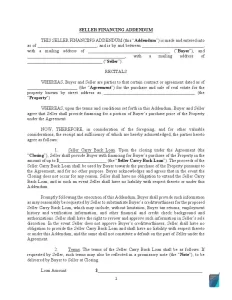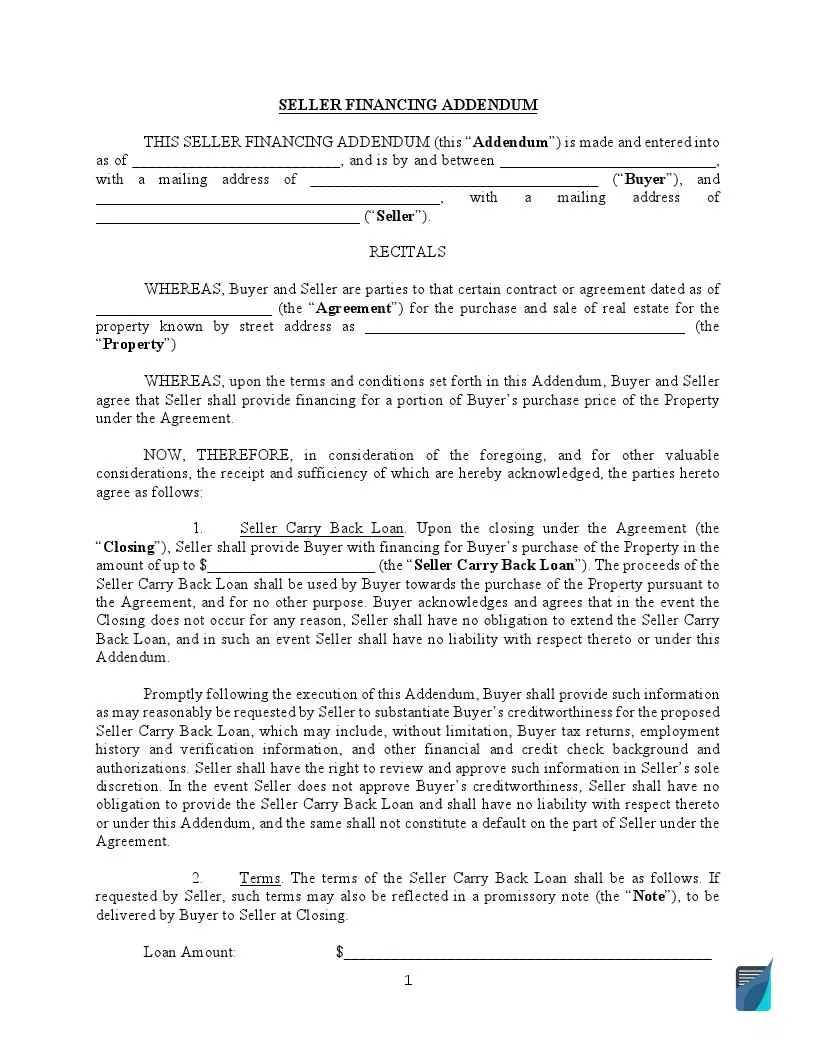Owner (Seller) Financing Contract
An owner or seller financing contract is an agreement between a buyer and seller about the seller providing finances to the buyer to let them buy the concerned real estate. The option is a great opportunity for those who do not want to go with traditional home mortgages. Read more about owner financing contracts in our article.
What Is an Owner Financing?
An owner financing contract is a tool that lets real estate buyers enter into a printable purchase agreement form with the provision that the seller will finance the purchase. This way, the buyer and the seller do not involve third parties such as bank institutions that traditionally provide financing to buyers willing to take out a mortgage. A seller commonly establishes a higher interest rate than financial institutions’ mortgage rates. They might also set a balloon payment due after at least five years. Buyers who have credit problems or income that is hard to prove are good candidates for owner loans.
For example, imagine that a seller advertises their property for $300,000. A prospective buyer who wants to purchase the home is a self-employed artist who cannot qualify for a traditional mortgage. They might decide to make a full-price offer and request the seller to finance the purchase with 15% ($45,000) down. The seller, provided that they don’t have a mortgage on the property, might decide to accept the offer requiring the buyer to sign a mortgage note. The real estate purchase agreement will state that the buyer will have to pay the purchase price back in ten years at a 7% rate of interest with a balloon repayment at the end of the term. This way, the buyer can buy the desired real estate at a flexible payment schedule while the seller collects a bigger amount of money in the course of the finance period.
Types of Seller Financing
There is a variety of owner-financing incentives that bring solutions to different home-buying needs.
- Seller-held financing. In this case, the purchase price, rate of interest, and other loan terms are all set by the seller. There is still room for negotiation – a prospective buyer can present a counteroffer if they want to discuss a more favorable interest.
- Junior mortgage. This type of financing implies that a buyer already has a mortgage, and the seller agrees to hold a second mortgage that equals the difference between the buyer’s first mortgage and the purchase price.
- Lease-purchase option. If a buyer needs time to enhance their credit history or save money for a down payment, this option might be the best fit. It is often structured to let the buyer have a part of their monthly payments and deposit credited by the seller.
What Are the Main Components of the Contract?
Along with the standard information about the buyer and seller, certain components should be included in every owner-financed loan.
Length of the loan
The addendum to real estate purchase contract should indicate over what period the buyer agrees to repay the loan. The period is completely up to the seller – they might establish a 5, 10, or 20-year period or any other timeframe. The most common period is from 5 to 10 years.
Down payment
The amount of money that the buyer has to pay to show their interest in the home is known as a down payment. The paid sum is applied toward the sales price, and the remaining sum of the purchase price is financed. For seller financing contracts, it is common to set a down payment at the level of 10%-20%. There is no minimum requirement, though.
Interest rate
As we have mentioned, loans financed by the owner typically imply higher interest rates than those offered by traditional lenders. It is connected with a seller taking on delinquency and default risk. A rate of interest is again completely up to the owner, but the average rates are 4% – 10%. One should always check their state usury laws regarding the maximum interest rate that can be charged on loan. it should be done before setting the rate of interest for a loan financed by the owner.
The document should also indicate the type of repayment:
- Mortgage with a fixed rate. When using this option, neither the interest rate nor payment changes within the specified period. A buyer gradually pays off the principal balance of the mortgage by making regular payments.
- Mortgage with an adjustable rate. In this case, the interest is changed with a certain periodicity.
- Mortgage loan with interest only. The essence of this type of loan is that the buyer pays interest only for a generally short amount of time, and after that, they make a large balloon repayment.
- Mortgage with a balloon payment. A balloon repayment is essentially a single payment that is made at the end of the loan. Sellers usually don’t want to wait for decades till the buyer pays their money back, which is why they might opt for a balloon mortgage. Installments are typically made for a not-long period of time, and the remaining sum is paid at the end of the mortgage period. The document should also explicitly tell what option of paying off the loan a buyer will have: to refinance the payment, use savings, or use money from the real estate sale.
Pros and Cons of Seller Financing for Buyers and Sellers
Buyer’s Perspective
Buyers obviously get some unbeatable benefits if they go with a seller-financed mortgage. But there might also be some complications that buyers should consider.
1. Buyers don’t want to pay a loan for a long term
If there is a balloon repayment option indicated by a seller, a buyer does not have to hold a note for more than five or ten years.
2. Buyers should not expect a better rate of interest than with a traditional mortgage
Even if a buyer thinks they might pay less interest rate than with a bank at first, they will still pay more, possibly some extra percentage points above the prevailing rate.
3. Buyers might need to sell themselves to get the deal
There is no reason for a buyer to hide the cause of them not qualifying for a traditional mortgage. When an owner conducts due diligence on the buyer, they will get information about their credit history, employment, etc. All the possible restrictions on the buyer’s ability to borrow money that are not presented in the list of available information should be made known to an owner as well. It is especially relevant in situations when a buyer has just started a business, and they cannot qualify for a mortgage for several years.
4. Buyer shouldn’t hesitate to propose seller financing
Not all homeowners consider offering seller financing options, which is why it would be prudent to ask an owner who sells a great home whether they are ready to sell the property to those who don’t qualify for mortgages. Instead of directly asking a seller about the option, a buyer might even turn to them with a specific proposal like: “I offer to split the purchase price in down payment at X percent, owner financing for $XXX,XXX at X percent, amortized over X years with an X-year balloon loan.”

Seller’s Perspective
For sellers who are considering financing the sale of real property, here are some pros and cons:
1. Sellers can move easier
If a seller needs to move in a short amount of time and does not succeed, the financing option might help them overcome some challenges arising from the sale of their property.
2. Sellers might earn some money
The option of financing the sale helps a seller get above-market interest rates.
3. Sellers might provide finances for a short time
Even if a seller finances the sale for 10 or 20 years, they might at any point sell the promissory note to a third party who will accept payments from a buyer. It means an owner should not necessarily be the lender or have cash. But a seller should remember that they will most likely lose 10%-35% of the sale price as a promissory note on real estate typically sells for 65% to 90% of their face value.
4. Sellers might seal the deal quicker with seller financing
Selling a property might be easier when an owner offers to finance the sale, as this option is not commonly used by property sellers. However, it is important to add details of the financing option to the property description.
Our online builder will help you fill out the form for the owner financing agreement in no time. All you need is to answer the set of questions and then download the document. However, before you use our template of an owner financing agreement, consult with an attorney to review certain aspects of the contract before you make a formal commitment. They will provide essential advice on checking the legality of the agreement, ways of detecting any existing encumbrances, and recordation.
Step 1 – Date, information about the parties
Start with its name and date of execution. Then, should specify the names, addresses, and contact numbers of both parties.
Step 2 – Description of the property
The legal description of the property concerned should go next in the document.
Step 3 – Contract amount
Further, the contract should indicate the price at which the buyer agrees to buy the property.
Step 4 – Interest rate
Here, mention what interest will be incurred by the financed amount annually.
Step 5 – Buyer’s credit information
This section should state the number of days that are given to the buyer to furnish the property owner with all credit, employment, and other financial information required by the latter.
Step 6 – Financing terms
The next section should set out the terms of the seller’s financing.
First, it should indicate what type of financing the owner offers: a balloon mortgage, a mortgage with a fixed rate, a mortgage with an adjustable rate, or a mortgage with interest only. The details of any chosen option should be specified in the contract.
Step 7 – Taxes and insurance
Next, the contract has to indicate whether or all property taxes and liability insurance will be escrowed. If they are not escrowed, the owner will be expecting proof of payment within the contract-specified number of days.
Step 8 – Pre-payment
Indicate whether or not a penalty will be imposed on the buyer in case they make an early payment before the last payment date.
Step 9 – Delay
Mention what will happen in case the buyer delays the payments. You might state that payment becomes due and might be demanded of the buyer immediately without any prior notice.
Step 10 – Changes to the contract
The contract should also have a paragraph about bringing changes to the document. It should say that any adjustments or modifications are valid only if they are in writing and signed by both parties.
Step 11 – Governing law
Here, indicate which state’s laws will apply to this contract.
Step 12 – Signatures
The signatures, names, and dates of both parties should finalize the contract.
Step 13 – Promissory note
The attached promise note of promise will include the important details about the loan. It should explicitly say that the borrower (buyer) promises to pay the lender (seller) the agreed amount at a specified rate of interest annually. The promise note should also include terms of repayment indicating the number of installments, frequency, and the date of the first payment. Other information to include in the note is counterparts, agreement modifications, non-waiver provision, and the governing law. The promissory note should be signed by the borrower.
